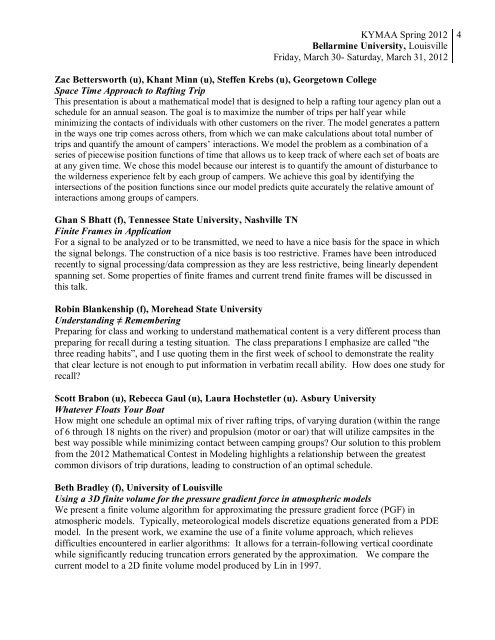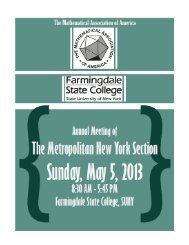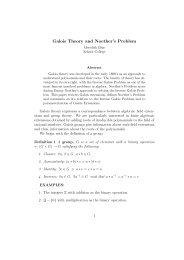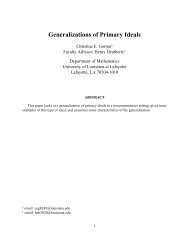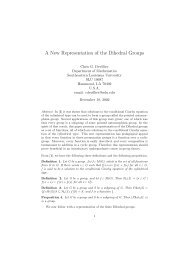Abstracts and Biographical Information - Sections - Mathematical ...
Abstracts and Biographical Information - Sections - Mathematical ...
Abstracts and Biographical Information - Sections - Mathematical ...
Create successful ePaper yourself
Turn your PDF publications into a flip-book with our unique Google optimized e-Paper software.
KYMAA Spring 2012<br />
Bellarmine University, Louisville<br />
Friday, March 30- Saturday, March 31, 2012<br />
Zac Bettersworth (u), Khant Minn (u), Steffen Krebs (u), Georgetown College<br />
Space Time Approach to Rafting Trip<br />
This presentation is about a mathematical model that is designed to help a rafting tour agency plan out a<br />
schedule for an annual season. The goal is to maximize the number of trips per half year while<br />
minimizing the contacts of individuals with other customers on the river. The model generates a pattern<br />
in the ways one trip comes across others, from which we can make calculations about total number of<br />
trips <strong>and</strong> quantify the amount of campers‟ interactions. We model the problem as a combination of a<br />
series of piecewise position functions of time that allows us to keep track of where each set of boats are<br />
at any given time. We chose this model because our interest is to quantify the amount of disturbance to<br />
the wilderness experience felt by each group of campers. We achieve this goal by identifying the<br />
intersections of the position functions since our model predicts quite accurately the relative amount of<br />
interactions among groups of campers.<br />
Ghan S Bhatt (f), Tennessee State University, Nashville TN<br />
Finite Frames in Application<br />
For a signal to be analyzed or to be transmitted, we need to have a nice basis for the space in which<br />
the signal belongs. The construction of a nice basis is too restrictive. Frames have been introduced<br />
recently to signal processing/data compression as they are less restrictive, being linearly dependent<br />
spanning set. Some properties of finite frames <strong>and</strong> current trend finite frames will be discussed in<br />
this talk.<br />
Robin Blankenship (f), Morehead State University<br />
Underst<strong>and</strong>ing ≠ Remembering<br />
Preparing for class <strong>and</strong> working to underst<strong>and</strong> mathematical content is a very different process than<br />
preparing for recall during a testing situation. The class preparations I emphasize are called “the<br />
three reading habits”, <strong>and</strong> I use quoting them in the first week of school to demonstrate the reality<br />
that clear lecture is not enough to put information in verbatim recall ability. How does one study for<br />
recall?<br />
Scott Brabon (u), Rebecca Gaul (u), Laura Hochstetler (u). Asbury University<br />
Whatever Floats Your Boat<br />
How might one schedule an optimal mix of river rafting trips, of varying duration (within the range<br />
of 6 through 18 nights on the river) <strong>and</strong> propulsion (motor or oar) that will utilize campsites in the<br />
best way possible while minimizing contact between camping groups? Our solution to this problem<br />
from the 2012 <strong>Mathematical</strong> Contest in Modeling highlights a relationship between the greatest<br />
common divisors of trip durations, leading to construction of an optimal schedule.<br />
Beth Bradley (f), University of Louisville<br />
Using a 3D finite volume for the pressure gradient force in atmospheric models<br />
We present a finite volume algorithm for approximating the pressure gradient force (PGF) in<br />
atmospheric models. Typically, meteorological models discretize equations generated from a PDE<br />
model. In the present work, we examine the use of a finite volume approach, which relieves<br />
difficulties encountered in earlier algorithms: It allows for a terrain-following vertical coordinate<br />
while significantly reducing truncation errors generated by the approximation. We compare the<br />
current model to a 2D finite volume model produced by Lin in 1997.<br />
4


